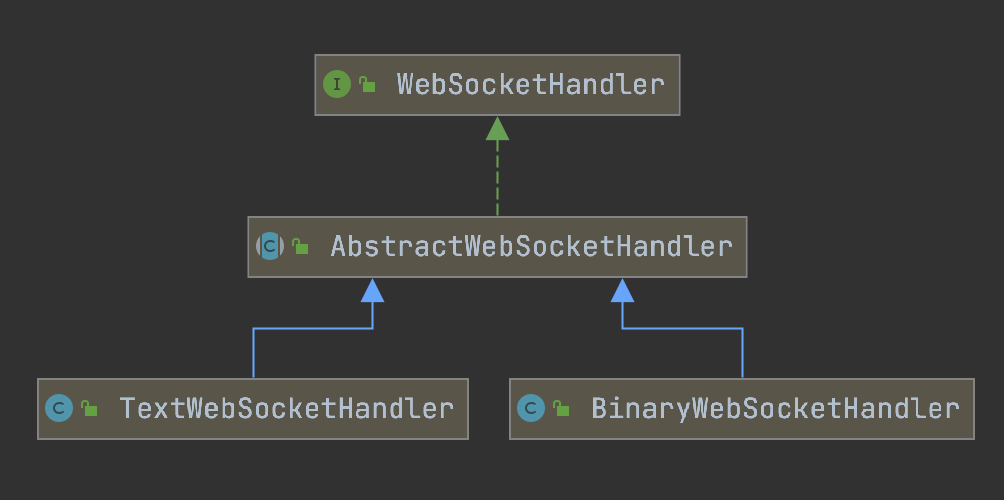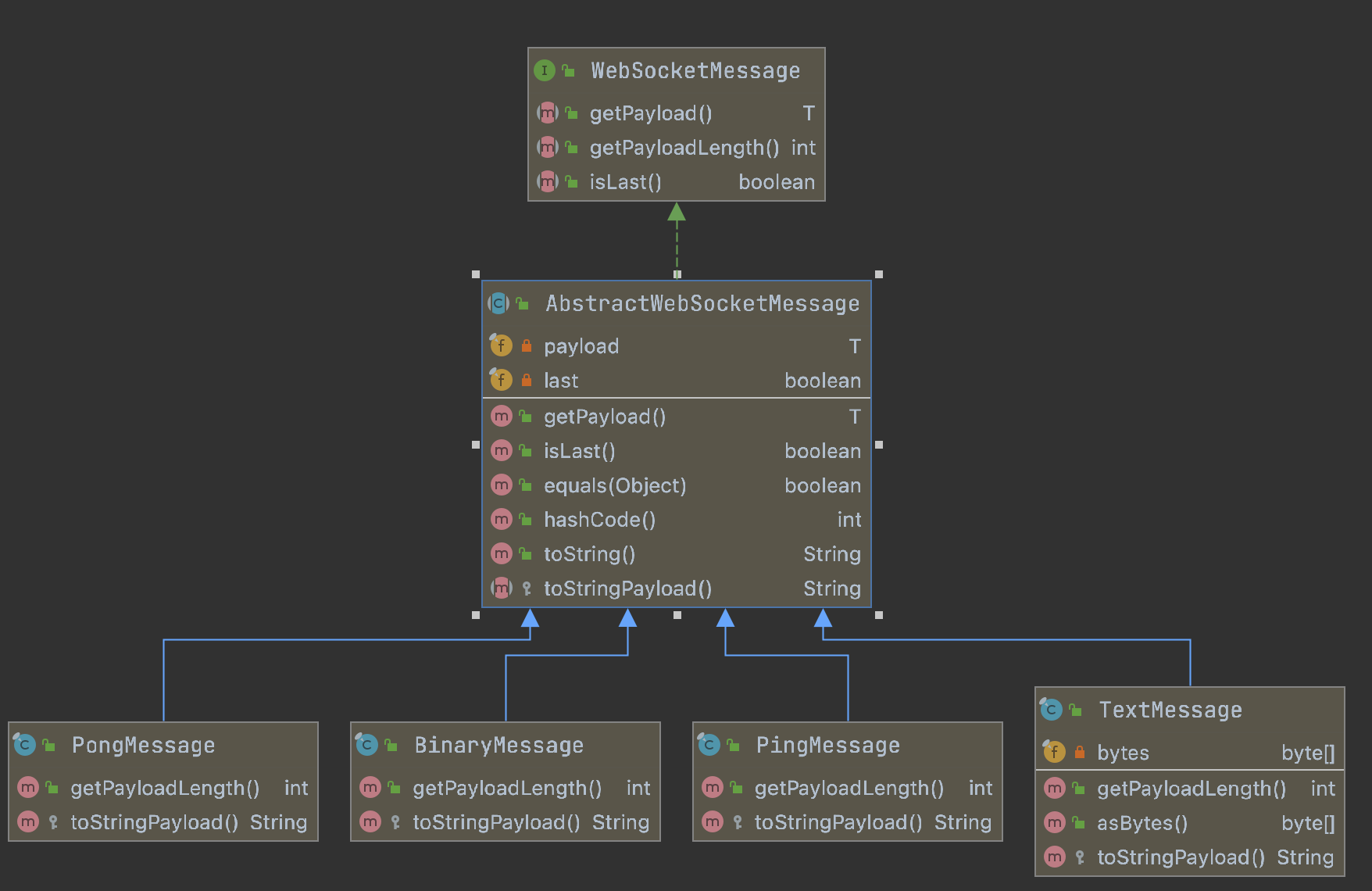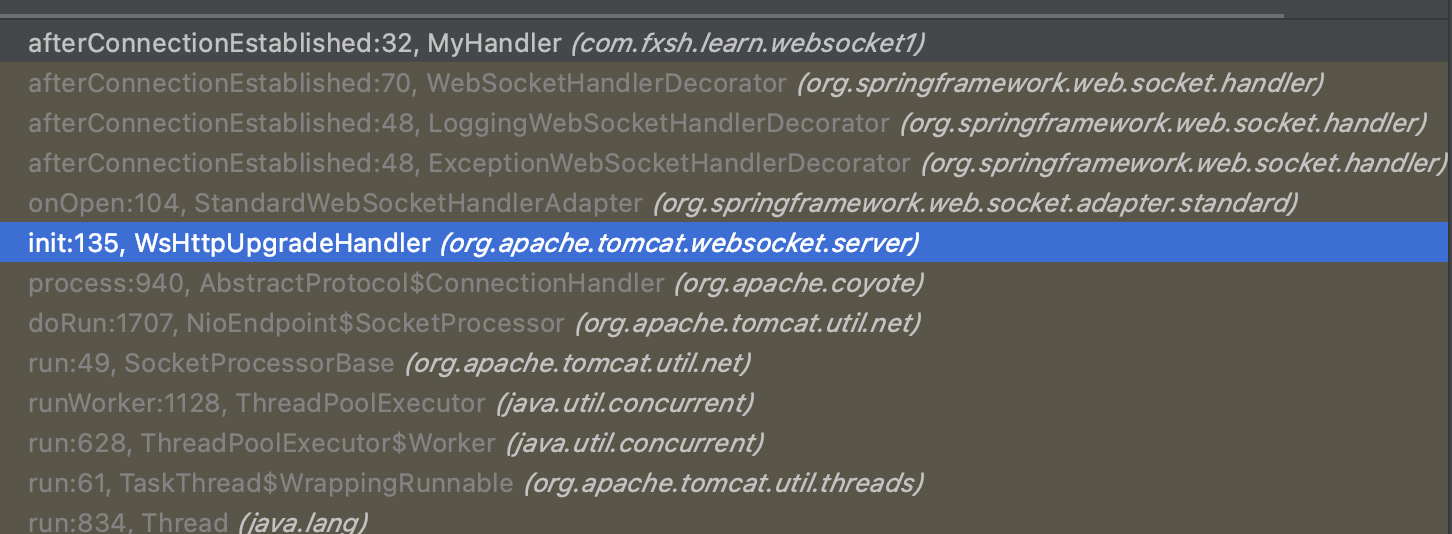SpringBoot中引入WebSocket
1、引入依赖
<dependency>
<groupId>org.springframework.boot</groupId>
<artifactId>spring-boot-starter-web</artifactId>
</dependency>
<dependency>
<groupId>org.springframework.boot</groupId>
<artifactId>spring-boot-starter-websocket</artifactId>
</dependency>
2、创建自己的处理类
该类可以实现org.springframework.web.socket.WebSocketHandler,也可以继承org.springframework.web.socket.handler.TextWebSocketHandler或org.springframework.web.socket.handler.BinaryWebSocketHandler
它们的继承关系如下图所示:

WebSocketHandler
public interface WebSocketHandler {
// 建立连接之后调用
void afterConnectionEstablished(WebSocketSession var1) throws Exception;
// 当新的WebSocket消息到达时调用
void handleMessage(WebSocketSession var1, WebSocketMessage<?> var2) throws Exception;
// 处理消息传输异常
void handleTransportError(WebSocketSession var1, Throwable var2) throws Exception;
// 在WebSocket连接被任意一方关闭后,或者发生传输错误之后调用
void afterConnectionClosed(WebSocketSession var1, CloseStatus var2) throws Exception;
/*
* WebSocket 是否支持处理部分消息,
* 若此标志设置为true,并且底层WebSocket服务器支持部分消息,
* 则大的 WebSocket 消息或未知大小的消息可能会被拆分并可能通过对handleMessage(WebSocketSession, WebSocketMessage)多次调用接收。
* 标志WebSocketMessage.isLast()指示消息是否部分以及它是否是最后一部分
*/
boolean supportsPartialMessages();
}
AbstractWebSocketHandler
public abstract class AbstractWebSocketHandler implements WebSocketHandler {
@Override
public void afterConnectionEstablished(WebSocketSession session) throws Exception {
}
@Override
public void handleMessage(WebSocketSession session, WebSocketMessage<?> message) throws Exception {
if (message instanceof TextMessage) {
handleTextMessage(session, (TextMessage) message);
}
else if (message instanceof BinaryMessage) {
handleBinaryMessage(session, (BinaryMessage) message);
}
else if (message instanceof PongMessage) {
handlePongMessage(session, (PongMessage) message);
}
else {
throw new IllegalStateException("Unexpected WebSocket message type: " + message);
}
}
protected void handleTextMessage(WebSocketSession session, TextMessage message) throws Exception {
}
protected void handleBinaryMessage(WebSocketSession session, BinaryMessage message) throws Exception {
}
protected void handlePongMessage(WebSocketSession session, PongMessage message) throws Exception {
}
@Override
public void handleTransportError(WebSocketSession session, Throwable exception) throws Exception {
}
@Override
public void afterConnectionClosed(WebSocketSession session, CloseStatus status) throws Exception {
}
@Override
public boolean supportsPartialMessages() {
return false;
}
}
可以看到除了handleMessage,其它方法都空方法,这些方法需我们在具体的业务中去实现。
该类还定义了三个方法: handleTextMessage,handleBinaryMessage,handlePongMessage,分别用来处理TextMessage,BinaryMessage和PongMessage,下图是WebSocketMessage的类图:

TextMessage的范型参数是String,BinaryMessage和PonMessage的范型参数都是ByteBuffer。
TextWebSocketHandler
public class TextWebSocketHandler extends AbstractWebSocketHandler {
@Override
protected void handleBinaryMessage(WebSocketSession session, BinaryMessage message) {
try {
session.close(CloseStatus.NOT_ACCEPTABLE.withReason("Binary messages not supported"));
}
catch (IOException ex) {
// ignore
}
}
}
可以看到,该处理类重写了handlerBinaryMessage方法,如果是使用该处理类,那么就只能处理字符信息,若是接收的是字节信息,将会关闭该连接。
BinaryWebSocketHandler
public class BinaryWebSocketHandler extends AbstractWebSocketHandler {
@Override
protected void handleTextMessage(WebSocketSession session, TextMessage message) {
try {
session.close(CloseStatus.NOT_ACCEPTABLE.withReason("Text messages not supported"));
}
catch (IOException ex) {
// ignore
}
}
}
与TextWebSocketHandler类同理,该处理类只能处理字节信息,若是接收到了字符信息,将会断开该连接。
根据业务的不同,若是只涉及到文本信息,那么我们可以继承TextWebSocketHandler;若是只需要传递二进制信息,那么可以继承BinaryWebSocketHandler;如果两种信息都有的话,可以继承AbstractWebSocketHandler或实现WebSocketHandler接口。
下面以继承TextWebSocketHandler为例:
public class MyHandler extends TextWebSocketHandler {
private List<WebSocketSession> sessions = new ArrayList<>();
@Override
protected void handleTextMessage(WebSocketSession session, TextMessage message) throws Exception {
/**
* 广播消息
*/
sessions.forEach(s -> {
if (!s.equals(session)){
try {
s.sendMessage(message);
} catch (IOException e) {
e.printStackTrace();
}
}
});
}
@Override
public void afterConnectionEstablished(WebSocketSession session) throws Exception {
/**
* 保存会话
*/
sessions.add(session);
}
@Override
public void afterConnectionClosed(WebSocketSession session, CloseStatus status) throws Exception {
/**
* 删除会话
*/
sessions.remove(session);
}
}
我们需要实现上面的3个方法,分别在建立连接时保存会话,收到消息时,将消息广播,然后再断开连接时删除相应的会话。
3、配置
@Configuration
@EnableWebSocket
public class WebsocketConfig implements WebSocketConfigurer {
@Override
public void registerWebSocketHandlers(WebSocketHandlerRegistry webSocketHandlerRegistry) {
webSocketHandlerRegistry.addHandler(myWebsocketHandler(),"myWS");
}
public WebSocketHandler myWebsocketHandler(){
return new MyHandler();
}
}
-
使用
@EnableWebSocket注解 -
实现
WebSocketConfigurer该接口只定义了一个接口:
/** * Defines callback methods to configure the WebSocket request handling * via {@link org.springframework.web.socket.config.annotation.EnableWebSocket @EnableWebSocket}. * * @author Rossen Stoyanchev * @since 4.0 */ public interface WebSocketConfigurer { /** * Register {@link WebSocketHandler WebSocketHandlers} including SockJS fallback options if desired. */ void registerWebSocketHandlers(WebSocketHandlerRegistry registry); }正如注释所说,通过
@EnableWebSocket,定义一个回调方法来配置WebSocket的请求处理类。在demo中,我们注册了一个自定义处理类,来处理来自/myWS的WebSocket消息。
至此,我们就可以使用Websocket进行消息广播了。
4、点对点通信
如果我们想要做到点对点的通信,那么我们需要将会话与客户端的关联关系保存下来。
我们可以通过以下方式获取在建立WebSocket连接的时候获取当前会话的登陆信息:
@Override
public void afterConnectionEstablished(WebSocketSession session) throws Exception {
Principal user = session.getPrincipal(); // 获取
log.info("User {} has connected",user.getName());
sessions.add(session);
}
用户信息都能获取到了,那点对点通信自然就不再话下了。
为什么WebSocketSession中会有用户信息呢?
我们在afterConnectionEstablished方法中打个断点,栈帧如图所示:

我在WsHttpUpgradeHandler.init中发现了下面这行代码:
try {
this.wsRemoteEndpointServer = new WsRemoteEndpointImplServer(this.socketWrapper, this.upgradeInfo, this.webSocketContainer);
//实例化WsSession
this.wsSession = new WsSession(this.ep, this.wsRemoteEndpointServer, this.webSocketContainer, this.handshakeRequest.getRequestURI(), this.handshakeRequest.getParameterMap(), this.handshakeRequest.getQueryString(), this.handshakeRequest.getUserPrincipal(), httpSessionId, this.negotiatedExtensions, this.subProtocol, this.pathParameters, this.secure, this.serverEndpointConfig);
this.wsFrame = new WsFrameServer(this.socketWrapper, this.upgradeInfo, this.wsSession, this.transformation, this.applicationClassLoader);
this.wsRemoteEndpointServer.setTransformation(this.wsFrame.getTransformation());
// 调用handler中的afterConnectionEstablished方法,
this.ep.onOpen(this.wsSession, this.serverEndpointConfig);
this.webSocketContainer.registerSession(this.serverEndpointConfig.getPath(), this.wsSession);
} catch (DeploymentException var10) {
throw new IllegalArgumentException(var10);
} finally {
t.setContextClassLoader(cl);
}
上面第8行onOpen方法最终会调用afterConnectionEstablished方法,而onOpen方法的第一行为:
public void onOpen(final javax.websocket.Session session, EndpointConfig config) {
/**
* 要注意区分这里的wsSession 和 init方法中的wsSession 是不同的对象
* init方法中的wsSession === session
* this.wsSession是StandardWebSocketSession的实例对象
**/
this.wsSession.initializeNativeSession(session);
...
this.handler.afterConnectionEstablished(this.wsSession);
}
public void initializeNativeSession(Session session) {
...
if (this.user == null) {
this.user = session.getUserPrincipal();
}
}
可以看到,handler中Principal user = session.getPrincipal();返回的user就是WsHttpUpgradeHandler.init中实例化的WsSession中的user。
我们再返回到上面WsHttpUpgradeHandler.init方法中的第4行,实例化WsSession时,向构造函数传了this.handshakeRequest.getUserPrincipal(),这就是用户登陆信息。
handshakeRequest是在preInit方法中赋值的
public void preInit(Endpoint ep, ServerEndpointConfig serverEndpointConfig, WsServerContainer wsc, WsHandshakeRequest handshakeRequest, List<Extension> negotiatedExtensionsPhase2, String subProtocol, Transformation transformation, Map<String, String> pathParameters, boolean secure) {
this.ep = ep;
this.serverEndpointConfig = serverEndpointConfig;
this.webSocketContainer = wsc;
// 得看看handshakeRequest中的Pringcipal那儿来的
this.handshakeRequest = handshakeRequest;
this.negotiatedExtensions = negotiatedExtensionsPhase2;
this.subProtocol = subProtocol;
this.transformation = transformation;
this.pathParameters = pathParameters;
this.secure = secure;
}
那我们在preInit方法中打个断点再康康:

UpgradeUtil.doUpgrade:
// HttpServletRequest req
WsHandshakeRequest wsRequest = new WsHandshakeRequest(req, pathParams);
......
wsHandler.preInit((Endpoint)ep, perSessionServerEndpointConfig, sc, wsRequest, (List)negotiatedExtensionsPhase2, subProtocol, transformation, pathParams, req.isSecure());
public WsHandshakeRequest(HttpServletRequest request, Map<String, String> pathParams) {
this.request = request;
this.queryString = request.getQueryString();
this.userPrincipal = request.getUserPrincipal(); // 破案了
this.httpSession = request.getSession(false);
this.requestUri = buildRequestUri(request);
......
}
至于为什么HttpServletRequest中有用户信息,那又是另一个故事了。
SpringBoot + STOMP
STOMP协议介绍
-
STOMP协议是一个简单的基于文本的通信协议,用于客户端之间通过消息中间件传递信息。
-
虽然STOMP协议是基于文本的协议,但它仍然可以用来传递二进制消息。
-
STOMP是一个基于帧的协议,该协议依赖一个可靠的双向流网络协议,如TCP,WebSocket等。客户端与服务端在网络流中传递STOMP帧,以达到通信的效果。
-
下面是一个场景的STOMP帧
-
SEND destination:/queue/a content-type:text/plain hello queue a ^@第一行:命令,命令一共有以下10种:
- CONNECT:客户端向服务端发送该命令来与客户端建立连接
- SEND:客户端向目的地(Destination) 发送消息
- SUBSCRIBE:客户端订阅某个目的地
- UNSUBSCRIBE:客户端取消订阅某个目的地
- BEGIN:用于开始一次通信
- COMMIT:用于提交一次通信
- ABORT:回滚通信
- ACK:消息同步,用户向目的地报告收到某个消息
- NACK:与
ACK相反 - DISCONNECT:客户端关闭与客户端的连接
- 优雅断开连接的方式:客户端向服务器发送DISCONNECT命令,并带有
receipt-id头信息,如果服务端已经收到了客户端发送的最后一条消息,那么将返回一个RECEIPT帧,然后客户端再断开连接
- 优雅断开连接的方式:客户端向服务器发送DISCONNECT命令,并带有
第二行至倒数第三行:头信息,键值对
倒数第二行:空行,用于将头信息和消息体隔开
最后是消息体,可以是文本也可能是二进制blob
这里只是简单的介绍,详细的介绍可以看官方文档,以后我可能会专门写一篇文章来介绍STOMP协议 🤔
-
Spring 引入STOMP
1、引入依赖
<dependency>
<groupId>org.springframework.boot</groupId>
<artifactId>spring-boot-starter-websocket</artifactId>
</dependency>
<dependency>
<groupId>org.springframework.boot</groupId>
<artifactId>spring-boot-starter-web</artifactId>
</dependency>
2、配置
@Configuration
@EnableWebSocketMessageBroker
public class WebSocketConfig implements WebSocketMessageBrokerConfigurer {
@Override
public void configureMessageBroker(MessageBrokerRegistry config) {
// 设置消息代理的前缀,如果消息的前缀为"/topic",就会将消息转发给消息代理(broker)
// 再由消息代理广播给当前连接的客户端
config.enableSimpleBroker("/topic");
// 下面方法可以配置一个或多个前缀,通过这些前缀过滤出需要被注解方法处理的消息。
// 例如这里表示前缀为"/app"的destination可以通过@MessageMapping注解的方法处理
// 而其他 destination(例如"/topic""/queue")将被直接交给 broker 处理
config.setApplicationDestinationPrefixes("/app");
}
@Override
public void registerStompEndpoints(StompEndpointRegistry registry) {
// 定义一个HTTP URL,供Websocket或SockJS客户端连接
// sockjs 可以解决浏览器对WebSocket的兼容性问题,客户端将通过这里配置的URL建立WebSocket连接
registry.addEndpoint("/stomp-ws").withSockJS();
}
}
- 使用
EnableWebSocketMessageBroker注解 - 实现
WebSocketMessageBrokerConfigurer,重写configuerMessageBroker和registerStompEndpoints方法
3、实现MessageMapping
@Controller
public class GreetingController {
@MessageMapping("/greetings") // 向/app/gretings 发送的消息都会通过该方法处理
@SendTo("/topic/greetings") // 方法的返回值会被发送给订阅了 /topic/greetings的客户端
public Greeting greeting(HelloMessage message) throws Exception{
Thread.sleep(1000);
return new Greeting("Hello " + HtmlUtils.htmlEscape(message.getName()) + "!");
}
}
4、前端
<script src="https://cdn.jsdelivr.net/npm/@stomp/stompjs@5.0.0/bundles/stomp.umd.js"></script>
<script>
stompClient = new StompJs.Client({
brokerURL: 'ws://localhost:8080/stomp-ws'
});
/**
* 建立连接之后的回调
*/
stompClient.onConnect = function (){
// 订阅一个destination
stompClient.subscribe('/topic/greetings',message =>{
showGreeting(JSON.stringify(message.body));
})
}
// 建立连接
stompClient.activate();
</script>
点对点通信
上面只是实现了消息的广播,如果我们想要向某个特定的用户发送消息呢?
向某个用户发送消息也有两种情况:
- 向本用户发送消息
- 向其他用户发送消息
向本用户发送消息
我们以获取当前时间为例,我们只需要做以下的修改:
1、新增一个消息代理:
@Override
public void configureMessageBroker(MessageBrokerRegistry config) {
// 新增 point 消息代理
config.enableSimpleBroker("/topic", "/point");
config.setApplicationDestinationPrefixes("/app");
}
2、新增一个MessageMapper
@MessageMapping("/getTime")
@SendToUser("/point/whatNow")
public String getTime(){
return "Now is " + LocalDateTime.now.format(DateTimeFormatter.ISO_LOCAL_DATE_TIME);
}
3、客户端订阅新增订阅 /user/point/whatNow
stompClient.onConnect = function (){
// 订阅一个destination
stompClient.subscribe('/user/point/whatNow',message =>{
showGreeting(JSON.stringify(message.body));
})
}
4、发送消息,获取当前时间
stompClient.publish({
destination:'/app/getTime',
body: null,
skipContentLengthHeader: true,
})
在第3步中,我们订阅了一个以user开头的Destination,Spring会将这类destination认定为向制定客户端发送消息。如上面的例子,我们订阅了/user/point/whatNow,这个destination会交由UserDestinationMessageHandler来处理
订阅时对destination的处理结果:

我们看到targetDestinations被解析为/point/whatNow-user{sessionId},所以客户端订阅的/user/point/whatNow经过UserDestinationMessageHandler的处理,最终订阅的destination是:/point/whatNow-user{sessionId};这样虽然表面上每个用户都订阅了相同的destination,但实际上每个客户端都有自己的destination,这样就可以向指定用户发送消息了。
返回消息时对destination的处理结果:

这里没有仔细研究,我猜测:我们使用@SendToUser("/point/whatNow")注解,在控制层的destination会变为:/user/{userName}/point/whatNow,然后通过UserDestinationMessageHandler的处理,找到真正的destination:/point/whatNow-user{sessionId}。
向他人发送消息
向他人发送消息,我们需要使用Spring提供的SimpMessagingTemplate
例如我们要向Jack发送当前时间,我们可以这样做:
@Autowired
private SimpMessagingTemplate messagingTemplate;
public void sendTime(){
String now = "Now is " + LocalDateTime.now.format(DateTimeFormatter.ISO_LOCAL_DATE_TIME);
messagingTemplate.convertAndSendToUser("Jack", "/point/whatNow",now);
}
当然,成功的前提是Jack客户端订阅了/user/point/whatNow






















 1253
1253











 被折叠的 条评论
为什么被折叠?
被折叠的 条评论
为什么被折叠?








